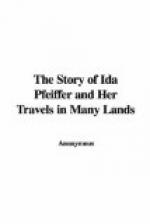Singapore is an island of fruits. It boasts of the delicious mangosteen, which almost melts in the mouth, and delights the palate with its exquisite flavour. It boasts, too, of splendid pine-apples, frequently weighing as much as four pounds. Also of sauersop, as big as the biggest pine-apples, green outside, and white or pale yellow inside, with a taste and fragrance like that of strawberries. Nor must the gumaloh be forgotten: it is divided, like the orange, into sections, but is five times as large, and not quite so sweet. Finally, we must refer to the custard-apple, which is very white (though full of black pips), very soft, and very enticing in flavour.
* * * * *
From Singapore we follow Madame Pfeiffer to Point de Galle, in Ceylon. The appearance of this fair and fertile island from the sea is the theme of every traveller’s praise. “It was one of the most magnificent sights I ever beheld,” says Madame Pfeiffer, “to see the island soaring gradually from the sea, with its mountain-ranges growing more and more distinctly defined, their summits lighted by the sun, while the dense cocoa-groves, and hills and plains, lay shrouded in shadow.” Above the whole towers the purple mass of Adam’s Peak; and the eye rests in every direction on the most luxuriant foliage, with verdurous glades, and slopes carpeted with flowers.
Point de Galle presents a curious mixture of races. Cingalese, Kanditons, Tamils from South India, and Moormen, with crimson caftans and shaven crowns, form the bulk of the crowds that throng its streets; but, besides these, there are Portuguese, Chinese, Jews, Arabs, Parsees, Englishmen, Malays, Dutchmen, and half-caste burghers, and now and then a veiled Arabian woman, or a Veddah, one of the aboriginal inhabitants of the island. Sir Charles Dilke speaks of “silent crowds of tall and graceful girls, wearing, as we at first supposed, white petticoats and bodices; their hair carried off the face with a decorated hoop, and caught at the back by a high tortoise-shell comb. As they drew near, moustaches began to show, and I saw that they were men; whilst walking with them were women naked to the waist, combless, and far more rough and ‘manly’ than their husbands. Petticoat and chignon are male institutions in Ceylon.”
* * * * *
Madame Pfeiffer, with unresting energy, visited Colombo and Kandy, the chief towns of the island. At the latter she obtained admission to the Temple of Dagoba, which contains a precious relic of the god Buddha—namely, one of his teeth. The sanctuary containing this sacred treasure is a small chamber or cell, less than twenty feet in breadth. It is enveloped in darkness, as there are no windows; and the door is curtained inside, for the more effectual exclusion of the light. Rich tapestry covers the walls and ceiling. But the chief object is the altar, which glitters with plates of silver, and is incrusted about the edges with precious stones.




